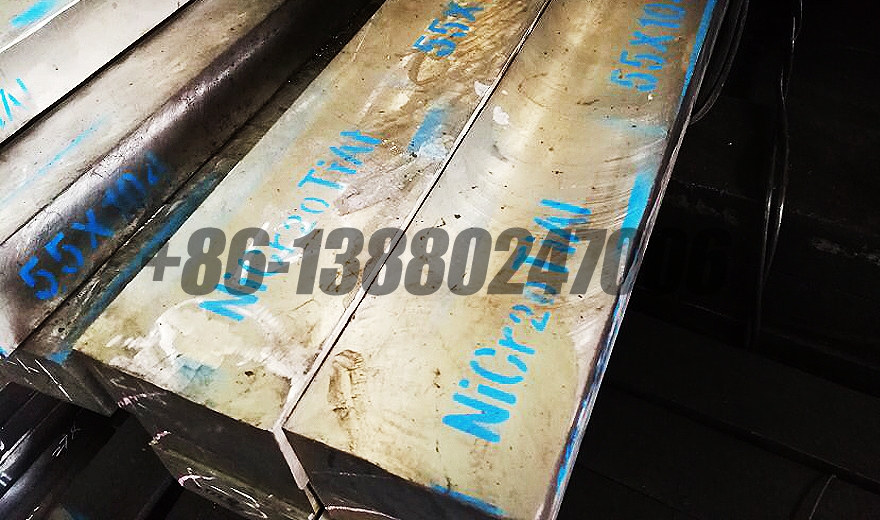Product Details
Nickel Alloy Bars
80A,
NiCr20TiAl HW 12792 Rev:04 Forging Flat Bar Milled.
Material properties of NiCr20TiAl
After heat treatment, the room temperature microstructure of
NiCr20TiAl is austenite as the matrix, and various strengthening phases such as γ', M23C6, M7C3, TiC, Ti(CN) (including TiN) and boride phase are dispersed, so that the alloy is in the range of 650-850. °C has good creep resistance and oxidation resistance. The composition and mechanical properties of high temperature alloy
NiCr20TiAl are shown in Table 1 and Table 2. The content of chromium is very high. At the same time, in order to obtain higher hardness value, the content of titanium and aluminum Generally close to the upper limit.
Deformation characteristics of NiCr20TiAl
As austenitic high-temperature heat-resistant alloy, NiCr20TiAl is one of the high-temperature deformation characteristics of the forging process, which is low in plasticity and large in deformation resistance. It can be seen from the tensile profile of the material of Figure 1. As the temperature increases, the plasticity of the material decreases significantly, while the tensile strength and yield strength decrease are not obvious. It can be inferred that, unlike the general nickel-based alloy, NiCr20TiAl has high temperature plasticity and large deformation resistance, which poses certain difficulties for hot forging. The second characteristic of deformation is that with the increase of alloying degree in the alloy, the initial of the alloy The melting temperature decreases, and the recrystallization temperature and the strengthening phase dissolution temperature increase. On the one hand, the upper limit of the processing temperature should be lower than the solid solution temperature; on the other hand, the temperature is increased to completely dissolve the hardened phase, thus determining the lower limit of the processing temperature, so that the forging temperature range of NiCr20TiAl is extremely narrow. Another characteristic of NiCr20TiAl is that its grain size mainly depends on the degree of deformation during hot working, deformation speed, deformation temperature and other factors. After forging, the grain cannot be refined by heat treatment. Therefore, the forging process of NiCr20TiAl directly affects its mechanics. Main factor of performance
Forging process of NiCr20TiAl
According to the material and deformation process characteristics of NiCr20TiAl, a series of forging process tests were carried out, and the best process parameters were selected to determine the following forging process suitable for mass production: Table 3 Mechanical properties of the first batch of seal ring forgings 2 Metallurgical organization of the first batch of seal ring forgings The forging of the valve stem is mainly formed by secondary drawing, and the degree of deformation will mainly depend on the head formed by the free forging and long process, that is, the forging ratio is based on the requirement of the head, and the forging ratio is ≥3.5. In order to meet the grain size requirements, it is mainly to control the degree of forging deformation, that is, the appropriate forging ratio. The heating temperature during forging and heat treatment should be strictly controlled. In particular, the amount of forging deformation of the last fire is controlled by the method of reserving the size of the forging. The heating temperature of the last fire is appropriately reduced to control the final forging temperature specified by the process. Trial production of forgings: The manufacture of valve stem forgings combines trial production with actual production, draws on the experience of sealing ring forging, and develops a reasonable process system. (1) Raw materials. The raw materials are made of φ380mm electric slag ingots. The original technical documents of the materials should be complete, and the materials should be inspected according to the regulations. (2) Heating specifications. In order to avoid excessive stress caused by temperature difference when the steel ingot is heated, the temperature of the ingot is not higher than 300 °C, and stays at 800~850 °C for a period of time. After the temperature of the ingot is uniform, the temperature is raised to 1,150 °C. It is not allowed to overheat, as shown in Figure 3, so the forging temperature range must be strictly controlled: 1,150 ± 10 °C area heating, Avoid overheating or overheating, resulting in excessive δ ferrite content, causing forging cracks, unsatisfactory mechanical properties or direct scrapping, etc.

